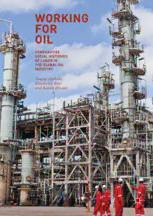
Working for Oil: Comparative Social Histories of Labor in the Global Oil Industry PDF
Preview Working for Oil: Comparative Social Histories of Labor in the Global Oil Industry
WORKING FOR OIL COMPARATIVE SOCIAL HISTORIES OF LABOR IN THE GLOBAL OIL INDUSTRY Touraj Atabaki, Elisabetta Bini and Kaveh Ehsani Working for Oil “Itisastonishinghowlittleissaidcurrentlyaboutthosemillionsofpeoplewhotoil for oil—the colossal industry that anchors the whole of the global political economy.Thisimportantvolumegivesanewlifetothefieldbybringingtogether valuablestudiesfromdifferentregionsoftheworld.Itisamust-readforthosewho want to understand the changing fortune of life and labor in the world’s most strategic energysector.” —AsefBayat, Professor ofSociology andBastianProfessor ofGlobalStudies atthe University ofIllinois, Urbana-Champaign “WorkingforOiloffersavaluablecompendiumofsocialrelationsacrossthemost vitalindustryofthetwentiethcentury.StretchingfromIrantoMexicoandtheU.S. Gulf Coast to Norway and Siberia, these studies highlight both the integrating discipline of the capitalist marketplace and the extraordinary diversity with which workersand theircommunities haveadapted to atechnologicalimperative.” —LeonFink, Distinguished Professor ofHistoryat theUniversity ofIllinois in Chicago,and theeditor ofthe journalLabor: Studiesin Working-Class History oftheAmericas “Whiletheliteratureonthepetroleumindustryisvast,researchaboutoilworkersis anything but. This collection addresses that gap, bringing together scholarship about labor from all oil regions of the world. The global and multidisciplinary approach is rich and complex, setting a high standard for future scholars and invitingthemto followsuit.” —MyrnaSantiago,Professor ofHistory atthe SaintMary’sCollege ofCalifornia “By attending to the complex role played by workers in the fossil fuel industries, thissplendidbookfillsamajorgapincontemporaryanalysesoftheoilindustry.The essays included in Working for Oil examine labor at important moments in the historyofoilandatkeysitesaroundtheworld,whileintroducingustothedistinct experiencesoforganizedlabor,women,andmigrantworkers.Superblyresearched, thiscollectionpromisestoreshapedebatesanddiscussionsinbothlaborstudiesand energystudiesfor yearsto come.Essential.” —Imre Szeman, Professor ofEnglish and CanadaResearch Chair ofCultural StudiesatUniversityofAlberta,andco-directorofthePetroculturesResearchGroup “Without oil the world economy would grind to a halt. Petroleum not only fuels carsandairplanes,itisalsousedtoproduceplastics,fertilizers,andcosmetics.We all know about the multinational corporations dominating the oil market, but we never hear much about the people who actually do the work, and produce the world’s major commercial energy source. The present volume offers a completely new perspective. It is a pioneering exploration of the oil proletariat, covering the historyofmajorproductionsitesonfivecontinents,andthedailylivesandstruggles of oil workers in these places. The book is indispensable reading for all those interested intheglobal historyoflabor.” —MarcelvanderLinden,SeniorResearcherattheInternationalInstituteofSocial History, Amsterdam “There is no convincing answer to the question why historians of the oil industry have ignored its workers nor why working class historians have ignored the oil sector,butthiscollection clarifieswhybothkindsofhistories aretheworseforit. Working for Oilis agamechanger.” —Robert Vitalis,Professor ofPolitical Science,University ofPennsylvania Touraj Atabaki Elisabetta Bini (cid:129) Kaveh Ehsani Editors Working for Oil Comparative Social Histories of Labor in the Global Oil Industry Editors TourajAtabaki Kaveh Ehsani International Institute forSocial DePaul University History Chicago, IL, USA Royal NetherlandsAcademyofArts andSciences Amsterdam, TheNetherlands ElisabettaBini University ofNaples FedericoII Naples,Italy ISBN978-3-319-56444-9 ISBN978-3-319-56445-6 (eBook) https://doi.org/10.1007/978-3-319-56445-6 LibraryofCongressControlNumber:2017938146 ©TheEditor(s)(ifapplicable)andTheAuthor(s)2018 Thisworkissubjecttocopyright.AllrightsaresolelyandexclusivelylicensedbythePublisher, whetherthewholeorpartofthematerialisconcerned,specificallytherightsoftranslation, reprinting, reuse of illustrations, recitation, broadcasting, reproduction on microfilms or in any other physical way, and transmission or information storage and retrieval, electronic adaptation, computer software, or by similar or dissimilar methodology now known or hereafterdeveloped. Theuseofgeneraldescriptivenames,registerednames,trademarks,servicemarks,etc.inthis publicationdoesnotimply,evenintheabsenceofaspecificstatement,thatsuchnamesare exemptfromtherelevantprotectivelawsandregulationsandthereforefreeforgeneraluse. Thepublisher,theauthorsandtheeditorsaresafetoassumethattheadviceandinformation in this book are believed to be true and accurate at the date of publication. Neither the publishernortheauthorsortheeditorsgiveawarranty,expressorimplied,withrespecttothe material contained herein or for any errors or omissions that may have been made. The publisher remains neutral with regard to jurisdictional claims in published maps and institutionalaffiliations. Coverillustration:©HybridImages/gettyimages Printedonacid-freepaper ThisPalgraveMacmillanimprintispublishedbySpringerNature TheregisteredcompanyisSpringerInternationalPublishingAG Theregisteredcompanyaddressis:Gewerbestrasse11,6330Cham,Switzerland C ONTENTS Introduction 1 Touraj Atabaki, Elisabetta Bini, and Kaveh Ehsani Disappearing the Workers: How Labor in the Oil Complex Has Been Made Invisible 11 Kaveh Ehsani Part I The Political Life of Oil The Zero-Sum Game of Early Oil Extraction Relations in Colombia: Workers, Tropical Oil, and the Police State, 1918–1938 37 Stefano Tijerina Fluid History: Oil Workers and the Iranian Revolution 69 Peyman Jafari Norwegian Oil Workers: From Rebels to Parters in the Tripartite System 99 Helge Ryggvik The Role of Labor in Transforming Nigerian Oil Politics 131 Andrew Lawrence v vi CONTENTS The End of “The Good Fight”? Organized Labor and the Petro-nationDuringtheNeoliberalizationoftheOilIndustry in Ecuador 159 Gabriela Valdivia and Marcela Benavides Part II The Productive Life of Oil Indian Migrant Workers in the Iranian Oil Industry 1908–1951 189 Touraj Atabaki Cat Crackers and Picket Lines: Organized Labor in US Gulf Coast Oil Refining 227 Tyler Priest White-Collar Wildcatters and Wildcat Strikes: Oil Experts, Global Contracts, and the Transformation of Labor in Postwar Houston 257 Betsy A. Beasley Heroic “Black Gold”? Working for Oil and Gas in the Western Siberian Oil and Gas Complex of the 1960–1970s 285 Dunja Krempin Part III The Social and Urban Life of Oil Building an Oil Empire: Labor and Gender Relations in American Company Towns in Libya, 1950s–1970s 313 Elisabetta Bini Tapline, Welfare Capitalism, and Mass Mobilization in Lebanon, 1950–1964 337 Zachary Davis Cuyler CONTENTS vii “Oil Is Our Wet Nurse”: Oil Production and Munayshilar (Oil Workers) in Soviet Kazakhstan 369 Saulesh Yessenova Doubly Invisible: Women’s Labor in the US Gulf of Mexico Offshore Oil and Gas Industry 399 Diane E. Austin Index 423 L I IST OF LLUSTRATIONS Fluid History: OilWorkers andtheIranian Revolution Fig. 1 Numberofworkersin theIranian oilindustry. 71 Fig. 2 Oil productionin millionb/d, August1978–January 1979. 75 Picture 1 Iranians queuingfor fuelinTehran. The smallprint Persian textreads: “Queuesthat arefew kilometres longemergedin thestreetsforgasolineandkerosene.Bagh-eShahgasstation, SepahStreet.”The large printstates: “Shortageofkerosene, gasoline, anddiesel.” 76 The Roleof Laborin Transforming NigerianOilPolitics Chart 1 Nigerianoilrevenues asapercentage ofGDP. 133 The End of“The GoodFight”?Organized Labor andthe Petro-nation DuringtheNeoliberalization of theOilIndustry in Ecuador Fig. 1 “TheWedding oftheYear.” 160 Fig. 2 PresidentCorrea smells“somethingfishy”goingonin Petroecuador.CaricaturebyAsdrúbaldelaTorre,DiarioHoy (2010,p. 5). 176 ix x LISTOFILLUSTRATIONS IndianMigrant Workers in theIranian OilIndustry1908–1951 Fig. 1 Oil fieldsandrefinery1928. 190 Fig. 2 Indian employmentin theAnglo-Persian/Anglo-Iranian Oil Company 1910–1950. 193 Fig. 3 Constructionofthe Gach-qaraguli(Gachsaran)Road, 1909. 194 Fig. 4 Power Station, AbadanRefinery, 1921. 200 Fig. 5 MapofAbadanin1926,showingthenewsuburbsbuiltinthe 1920sand1930s. 206 Fig. 6 Foundry, Abadan, 1921. 211 CatCrackers andPicket Lines: Organized Labor inUS GulfCoast OilRefining Fig. 1 Catalytic Cracking Units, StandardOil ofNewJersey BaytownRefinery, 1946. 228 Fig. 2 Cover art,Harvey O’Connor, HistoryofOil Workers International Union-CIO(Denver, CO:Oil Workers International Union, 1950). 236 Fig. 3 Cat CrackerControl Room,ShellOil DeerPark Refinery. 242 Fig. 4 OCAW Local4-367Picketers, ShellOil 1962Strike. 247 “OilIs OurWetNurse”: OilProduction andMunayshilar (Oil Workers)in Soviet Kazakhstan Fig. 1 1955.MastersofsubsurfacewellrepairK.Zhusupov(left)and A. Karzhauov(right), theKulsary oilfield. Courtesyof the AldongarPublic FoundationforCultural Development, Almaty. 377 Fig. 2 1943. OperatorK. Begembetova,theShubarduk oilfield. Courtesy oftheAldongar PublicFoundation forCultural Development, Almaty. 378 Fig. 3 Bagit Kulbaevand hiswife, SvetlanaKulbaeva,in 2011.All fiveoftheirchildren—threedaughtersandtwosons—workin Kazakhstan’s oilindustry. 379 Fig. 4 Sarakamis(2004).OneofthelastfamiliestoleaveSarakamis, shownherewith visitorsfrom Kulsary. 382
